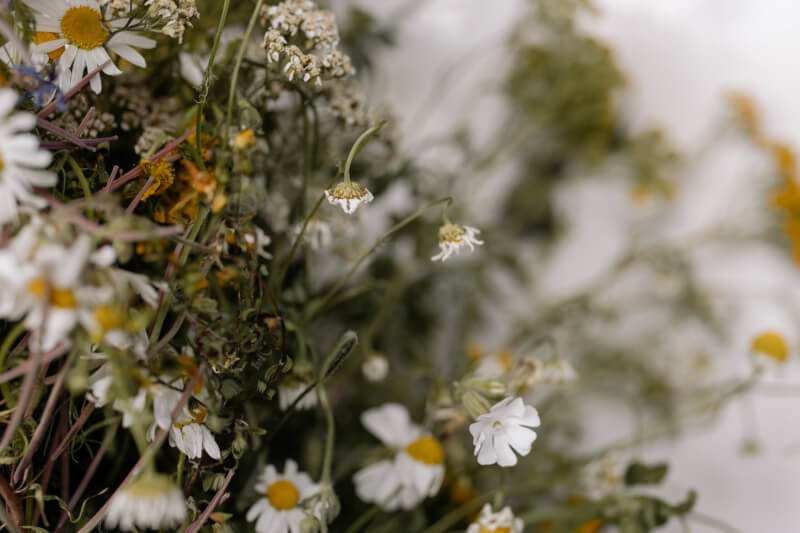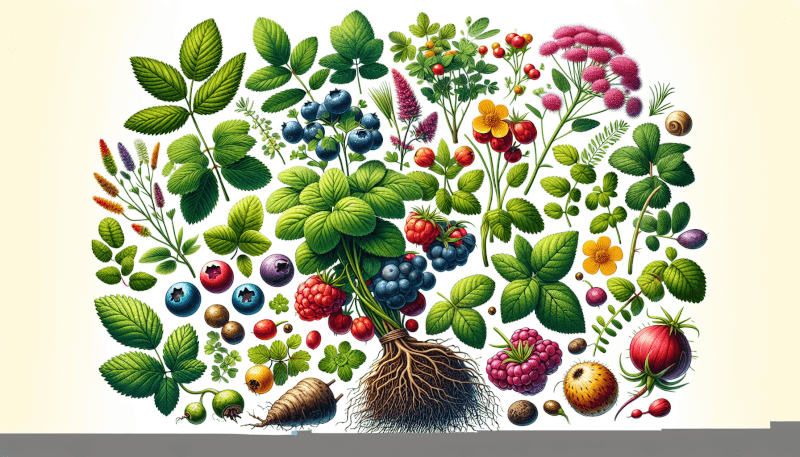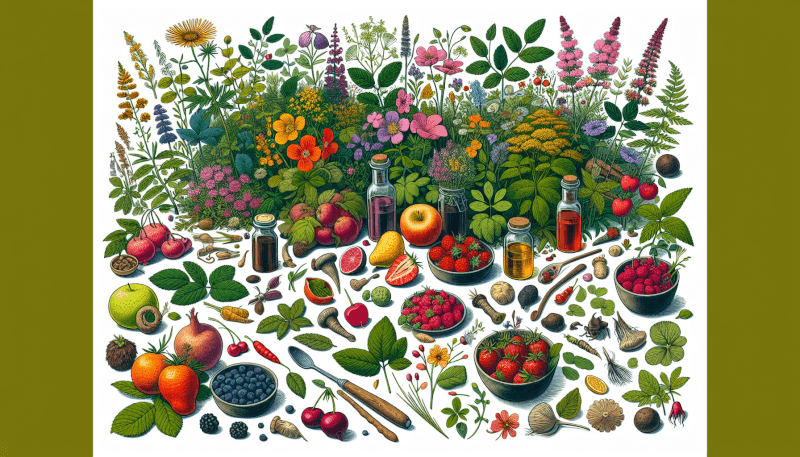Imagine being able to walk through a forest or hike through the countryside, knowing which plants are not only beautiful but also delicious and nutritious. With “The Complete Guide To Edible Wild Plants,” you’ll unlock the secrets of nature’s bountiful pantry. From identifying common edible plants to learning how to safely forage and prepare them, this comprehensive guide is your ticket to a sustainable and flavorful outdoor adventure. So lace up your boots, grab your compass, and get ready to explore the wild world of culinary possibilities that Mother Nature has to offer.

Identifying Edible Wild Plants
When venturing into the world of foraging, it is essential to be able to identify edible wild plants accurately. While there are numerous edible plants in nature, it is important to exercise caution and ensure you are confident in your identification skills before consuming any wild plants. To assist you in this process, we will explore common edible plants, how to distinguish look-alike plants, and useful field guides and resources for identification.
Common Edible Plants
There are several edible plants that are commonly found in the wild. These include dandelion (Taraxacum officinale), stinging nettle (Urtica dioica), wild garlic (Allium vineale), chickweed (Stellaria media), lambsquarters (Chenopodium album), purslane (Portulaca oleracea), and wild berries (Rubus spp.). These plants offer a range of flavors and textures, making them valuable additions to any forager’s repertoire.
Distinguishing Look-alike Plants
Identifying edible wild plants becomes more challenging when they have look-alike counterparts that may be toxic or inedible. For example, wild parsnip (Pastinaca sativa) closely resembles the edible carrot (Daucus carota). It is essential to pay careful attention to distinguishing features such as leaf shape, color, and growth pattern to avoid any potentially harmful mix-ups. Consulting reliable references or field guides can be invaluable in distinguishing between similar-looking plants.
Useful Field Guides and Resources
When starting your foraging journey, having reliable field guides and resources at your disposal is crucial. These references provide detailed descriptions, photographs, and illustrations that can assist in accurate plant identification. Some popular field guides include “The Forager’s Harvest” by Samuel Thayer, “Edible Wild Plants: Eastern/Central North America” by Lee Allen Peterson, and “A Field Guide to Edible Wild Plants” by Bradford Angier. Additionally, joining local foraging groups or attending workshops can provide valuable hands-on learning experiences and knowledge-sharing opportunities.
Foraging Techniques
Now that you have a grasp of identifying edible wild plants, let’s delve into the techniques and considerations for successful foraging. Understanding when and where to forage, practicing ethical foraging, and having the right tools and equipment are all essential aspects of the foraging process.
When and Where to Forage
Timing and location play a crucial role in foraging success. Different plants have specific growing seasons, and it is essential to be aware of when they are at their prime to maximize the yield of edible parts. Spring is a bountiful time for foraging, with many plants producing fresh shoots and leaves. Summer offers an abundance of fruits and berries, while autumn provides an array of nuts and seeds. Winter foraging can be more challenging but still offers opportunities to gather certain hardy plants.
Finding the right foraging spot is equally important. Woodlands and forests are rich in edible mushrooms, while meadows and grasslands offer various edible greens. Coastlines and marshes provide an array of edible seaweeds and coastal plants, and mountains and alpine regions yield unique alpine herbs and berries. Researching the native plants in your area and understanding their preferred habitats will assist you in selecting optimal foraging locations.
Ethical Foraging Practices
Responsible foraging involves practicing ethical considerations to ensure the sustainability and preservation of natural ecosystems. Here are some guidelines to keep in mind:
Harvest only what you need: Take only the amount of plants or plant parts necessary for your immediate use, allowing the remaining plants to continue their lifecycle undisturbed.
Respect protected areas and private property: Be mindful of local regulations and avoid foraging in protected areas or on private property without permission.
Leave no trace: Minimize your impact by treading lightly, not trampling on other plants, and properly disposing of any waste you may generate while foraging.
Avoid endangered or rare species: Steer clear of collecting plants that are rare or endangered, as they need extra protection to recover their populations.
By following these ethical guidelines, you can enjoy foraging while ensuring the sustainability and longevity of wild plant populations.
Tools and Equipment
Having the right tools and equipment can enhance your foraging experience and make the process more efficient. Here are some essential items to consider:
Foraging basket or bag: A sturdy container to carry your harvested plants, allowing for proper airflow and easy transportation.
Garden gloves: Protect your hands from thorns, stinging nettles, or any other potential hazards.
Pruning shears or scissors: Useful for cleanly and safely harvesting plants without damaging them or other nearby vegetation.
Field guide or smartphone app: Carry a reliable reference to assist with plant identification in the field.
Waterproof clothing and footwear: Dress appropriately for the weather and terrain, as foraging can sometimes take you off the beaten path.
Water and snacks: Stay hydrated and nourished during your foraging adventures to ensure an enjoyable experience.
By being equipped with the right tools and gear, you can explore nature confidently and make the most out of your foraging endeavors.

Edible Parts of Wild Plants
In the world of edible wild plants, various parts of a plant can be utilized for consumption. From roots and tubers to leaves and shoots, flowers and buds, fruits and berries, and nuts and seeds, understanding the edible parts of each plant can expand your culinary possibilities in the wild.
Roots and Tubers
Roots and tubers are often hidden treasures beneath the earth’s surface. Common edible roots and tubers include wild carrots, wild onions, burdock, and wild yams. When foraging for these underground delights, be sure to carefully dig them up, ensuring minimum disruption to the surrounding soil and plant.
Leaves and Shoots
Leaves and shoots are the most accessible parts of many edible wild plants. Dandelion leaves, nettles, and lambsquarters are all delicious examples. When harvesting leaves and shoots, avoid taking the entire plant to allow for regrowth and sustainability.
Flowers and Buds
The blossoms of certain wild plants are not only beautiful but also edible. Violet flowers, chamomile, and elderflower are just a few examples. Harvest flowers and buds in moderation, allowing some to remain for pollinators and seed production.
Fruits and Berries
One of the highlights of foraging is the opportunity to gather delicious fruits and berries from nature’s bounty. Blackberries, raspberries, and wild strawberries are familiar examples. Be mindful of the appropriate ripe stage for each fruit and berry when harvesting to ensure optimal flavor.
Nuts and Seeds
Nuts and seeds are essential sources of fats and proteins in the wild. Acorns, hickory nuts, and pine nuts are among the edible varieties you may encounter. Learning the proper methods for processing and preparing nuts and seeds is crucial to remove any bitterness or toxins they may contain.
Understanding the edible parts of wild plants allows you to utilize a wide range of flavors, textures, and nutrients in your foraged meals.
Preparation Methods
Once you have successfully identified and harvested edible wild plants, proper preparation is essential to ensure their safety and enhance their flavors. Cleaning and washing, cooking techniques, drying and preserving, and making teas and infusions are all crucial steps in transforming your foraged finds into delightful culinary creations.
Cleaning and Washing
Before consuming any wild plant, thorough cleaning and washing are necessary to remove any dirt, insects, or other impurities. Gently rinse your foraged plants under cold water, being careful not to damage delicate leaves or flowers. A salad spinner or paper towels can be used to remove excess moisture after washing.
Cooking Techniques
Cooking wild plants can help enhance their flavors while also breaking down any potential toxins or antinutrients they may contain. Sauteeing, blanching, or stir-frying are popular cooking techniques for delicate leaves and shoots. Boiling or steaming can be used for root vegetables and tubers, while roasting works well for nuts and seeds.
Drying and Preserving
To extend the shelf life of your foraged plants, consider drying and preserving them. Air drying, dehydrating, or using a food dehydrator are effective methods to remove moisture from herbs, flowers, and berries. Once dried, store them in airtight containers in a cool, dry place to maintain their flavor and nutritional value.
Making Teas and Infusions
In addition to culinary uses, many wild plants can be utilized for making fragrant and flavorful teas and infusions. Dried flowers, leaves, and even roots are commonly steeped in hot water to extract their beneficial properties. Experiment with different combinations of wild plants to create unique and soothing herbal concoctions.
By employing these various preparation methods, you can transform your foraged wild plants into delightful culinary creations while ensuring their safety and enhancing their flavors.

Safety Guidelines
While foraging for edible wild plants can be a rewarding and sustainable practice, it is essential to prioritize safety to avoid any potential risks or adverse reactions. Understanding how to avoid poisonous plants, recognizing allergic reactions and sensitivities, and testing unfamiliar plants can help ensure a safe foraging experience.
Avoiding Poisonous Plants
The most critical aspect of foraging safely is the ability to differentiate between edible and toxic plants. Familiarize yourself with known poisonous plants in your area and learn to identify their distinguishing features. Some common poisonous plants include poison ivy, hemlock, and deadly nightshade. When in doubt, always err on the side of caution and avoid consuming any plant unless you are confident of its edibility.
Allergic Reactions and Sensitivities
Just like with any new food, some individuals may have allergic reactions or sensitivities to specific wild plants. It is advised to start with small quantities when trying a new edible plant for the first time. Observe your body’s reactions and discontinue consumption if you experience any adverse effects such as itching, swelling, or difficulty breathing.
Testing Unfamiliar Plants
When encountering new or unfamiliar plants, it is crucial to proceed with caution. Consult reliable references or experts to ensure accurate identification, and consider conducting a sensitivity test before consuming a larger quantity. Rub a small portion of the plant on a small area of your skin, wait for at least 24 hours, and observe for any adverse reactions. If no reaction occurs, try a small portion of the plant in your mouth and wait for further observations before consuming more.
Prioritizing safety while foraging will help you avoid potential health risks and enjoy a worry-free experience in nature.
Nutritional Value of Wild Plants
Beyond their enticing flavors and textures, wild plants offer a wealth of nutritional benefits. Rich in vitamins, minerals, antioxidants, and phytochemicals, incorporating edible wild plants into your diet can provide a valuable nutritional boost.
Vitamins and Minerals
Edible wild plants are often nutrient powerhouses, packed with essential vitamins and minerals. For example, dandelion greens are abundant in vitamins A, C, and K, as well as calcium and iron. Stinging nettle is known for its high levels of vitamin C and iron, making it a valuable addition to a well-rounded diet.
Antioxidants and Phytochemicals
Many wild plants boast high levels of antioxidants and phytochemicals, which can contribute to overall health and well-being. Elderberries, for instance, are renowned for their immune-boosting properties due to their antioxidant content. Blueberries, a common wild berry, are also revered for their antioxidant capacity and potential health benefits.
Balancing Wild Plant Diets
While wild plants offer numerous nutritional benefits, it is important to balance your diet with a variety of foods from different sources. Incorporating wild plants alongside a well-rounded diet that includes fruits, vegetables, grains, and proteins ensures a diverse nutrient intake. Consult a healthcare professional or nutritionist to ensure your wild plant consumption aligns with your specific dietary needs.
By appreciating the nutritional value of edible wild plants, you can maximize their benefits and contribute to a healthy and balanced lifestyle.

Common Edible Wild Plants
There is a multitude of edible wild plants, each with its unique characteristics and culinary potential. Here are some commonly encountered edible wild plants:
Dandelion (Taraxacum officinale)
Dandelions are recognizable by their bright yellow flowers and distinctive tooth-like leaves. They are extremely versatile and can be used in salads, sautéed as greens, or even brewed into a flavorful tea.
Stinging Nettle (Urtica dioica)
Despite its stinging reputation, stinging nettle offers numerous health benefits and culinary uses. Once properly cooked or dried, it loses its sting and can be used in soups, stews, or as a tea ingredient.
Wild Garlic (Allium vineale)
Wild garlic, also known as garlic mustard, can be easily identified by its distinctive garlic aroma. The leaves and stems add a flavorful punch to various dishes such as pesto, sauces, or simply as a garnish.
Chickweed (Stellaria media)
Chickweed is a delicate herb with tiny white flowers. It has a mild, slightly sweet flavor and can be used in salads, stir-fries, or cooked as greens.
Lambsquarters (Chenopodium album)
Lambsquarters, also known as wild spinach, is a leafy green plant that can be used as a nutritious substitute for spinach in various recipes. Its mild flavor makes it a versatile addition to soups, stews, or sautés.
Purslane (Portulaca oleracea)
Purslane is a succulent plant with a tart and slightly lemony flavor. It can be enjoyed raw in salads or steamed as a side dish.
Wild Berries (Rubus spp.)
Wild berries, such as blackberries, raspberries, and huckleberries, are nature’s sweet treat. Enjoy them fresh, bake them into pies and crumbles, or make delicious jams and jellies.
By familiarizing yourself with these common edible wild plants, you can expand your culinary repertoire and confidently identify these valuable and delicious finds in nature.
Edible Plants by Habitat
Wild plants adapt and thrive in various habitats, which affects their growth patterns and availability. Here are some notable habitats and the edible plants you may encounter within them:
Woodlands and Forests
Woodlands and forests are home to an array of edible plants, including mushrooms, such as morels and chanterelles, as well as wild berries like blackberries and elderberries. Nettles, garlic mustard, and violets are also common edible plants found in the shade of the forest understory.
Meadows and Grasslands
Meadows and grasslands offer an abundance of edible greens and flowers. Look out for plants like chicory, wild carrot, and wild onion for culinary delights. The sunny meadows often hold an assortment of edible herbs like dandelion, yarrow, and wild chamomile, which can be used for salads, teas, or infusions.
Coastlines and Marshes
Coastal regions and marshes provide unique opportunities for foraging. Seaweeds, such as kelp, nori, and Irish moss, offer a variety of flavors and are rich in minerals. Coastal plants like beach peas, samphire, and sea aster offer different culinary possibilities with their salty and briny tastes.
Mountains and Alpine Regions
Mountainous and alpine regions boast an array of edible plants that have adapted to harsher conditions. Alpine herbs like arnica, juniper, and yarrow can be used for teas, infusions, or flavorings. Berries such as cloudberries and lingonberries are prized finds at higher elevations.
Knowing which edible plants thrive in specific habitats can guide your foraging adventures and increase your chances of finding delightful treasures in nature.

Edible Plants by Season
Different seasons offer varying opportunities for foraging, as plants go through cycles of growth, flowering, and fruiting. Here are the highlights of each season for foraging edible wild plants:
Spring Foraging
Spring is a vibrant season for foraging, with an abundance of fresh shoots, leaves, and flowers available. Look out for young dandelion greens, stinging nettle tops, and violet flowers for early culinary adventures. Garlic mustard, chickweed, and lambsquarters also emerge during this time, providing a fresh burst of flavors for salads and sautés.
Summer Foraging
Summer is a time for fruits and berries, with an array of wild treats ripening in the sun-soaked days. Blackberries, raspberries, and wild strawberries are often found in hedgerows and meadows. Edible flowers like elderflower and chamomile also make their presence known, offering fragrant infusions and delightful floral flavors to beverages and desserts.
Autumn Foraging
Autumn is when nature’s bounty truly shines, with nuts and seeds taking center stage. Acorns, hickory nuts, and chestnuts provide a nutritious and versatile addition to your foraged ingredients. Meanwhile, wild mushrooms such as porcini and oyster mushrooms can be found in abundance, adding unique flavors and textures to dishes.
Winter Foraging
Winter foraging can be more challenging, as plant growth slows down and most foliage disappears. However, resilient plants like rose hips, wintergreen, and various evergreen needles can still be discovered, offering opportunities for vitamin-rich teas and infusions that provide a taste of the wild even in the colder months.
By embracing the seasons and their offerings, you can embark on a year-round journey of discovering and enjoying the diversity of edible wild plants.
Culinary Uses of Wild Plants
Edible wild plants can be incorporated into a variety of culinary creations, adding unique flavors, textures, and nutritional benefits. Here are some ways to utilize wild plants in the kitchen:
Wild Salads
Wild greens and flowers can elevate salads to a whole new level. Combine dandelion greens, chickweed, lambsquarters, and violets for a vibrant and nutrient-rich salad. Add edible flowers like nasturtiums or pansies for a pop of color and an extra touch of beauty on your plate.
Soups and Stews
Wild plants can bring depth and complexity to soups and stews. Add stinging nettle, fireweed shoots, or chicory leaves to your favorite vegetable soup for a nutritious twist. For a hearty stew, incorporate wild mushrooms, such as morels or chanterelles, along with root vegetables like burdock or wild carrot.
Herbal Teas
Wild plants are excellent choices for creating soothing and flavorful herbal teas. Combine dried flowers like chamomile, elderflower, and yarrow for a calming and aromatic infusion. Nettle tea provides a refreshing and mineral-rich brew, while wild mint or bergamot leaves can add a cooling zest to hot or iced teas.
Wild Plant Seasonings
Infuse your dishes with wild flavors by creating homemade seasonings. Dry and crush dried nettles, dandelion leaves, and wild garlic to make a nutritious and aromatic seasoning blend. Sprinkle it on roasted vegetables, grilled meats, or even popcorn for a unique twist.
With a little creativity and a willingness to experiment, the culinary potential of wild plants is limitless. Let your imagination guide you as you explore the countless ways to incorporate these natural treasures into your meals.
In conclusion, foraging for edible wild plants can be an enriching and delicious experience. By educating yourself on plant identification, practicing ethical foraging, and utilizing proper tools and techniques, you can safely and responsibly enjoy the vast array of edible plants found in nature. From understanding the various parts of wild plants to their nutritional value and culinary uses, this complete guide equips you with the knowledge and inspiration to embark on your own foraging adventures. So grab your basket, head out into nature, and discover the flavors and wonders that await you in the edible wild plants all around. Happy foraging!


